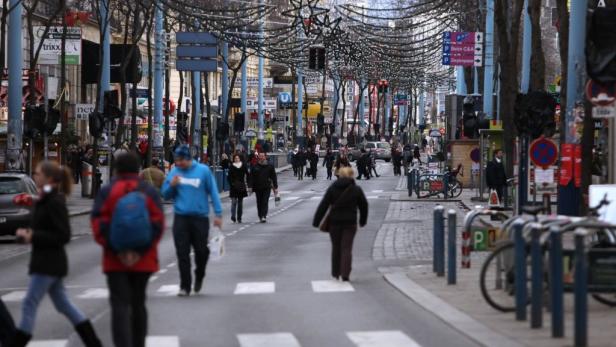
Mariahilfer Straße: Vision instead of whining
Dieser Artikel ist älter als ein Jahr!
Things have been very different on Mariahilfer Straße in Vienna since August 16. The middle section of the street that used to be open to car traffic in both directions is now divided into a pedestrian zone and two “encounter zones” where pedestrians, bicycles and automobiles have the same rights. The new traffic system has generated much debate. Pedestrians, bicycles and public transportation have attained a new position on Mariahilfer Straße. And cars are the clear losers. But it would not be Vienna if each of the groups did not have some complaint about the new rules.
Vice mayor and councilwoman for transportation Maria Vassilakou has been especially harshly criticized for having implemented a half-hearted solution. A solution designed to please everyone, but that no one wants in the end. There was a great deal of political and emotional discussion about the new system in the first days after it was implemented.
Strong emotions
“I honestly understand each group that has a problem with it,” mobility behavior researcher Alexandra Millonig from the AIT Austrian Institute of Technology said. She put the current discourse in perspective by saying, “But it is too soon to say what the real problems are.” First, the problems that all participants are having must be examined, and everyone has to adapt to the new conditions. No serious discussion can be held until then.
According to Millonig, one thing that has made the discussion so heated, as can be seen in online comments, for example, is that almost every person living in or visiting Vienna is affected by the issue. And people who think they have a well founded opinion are especially happy to engage in debate. But people usually fail to take the positions of other road users into account.
Encounters as a danger
The successful interaction of different users on Mariahilfer Straße is to be shown above all in the “encounter zones.” The name chosen for these areas reflects the hope that there will be no conflicts there, said Millonig. “There are examples that show that there do not necessarily have to be conflicts in such a mixed-zone. But perhaps it is also this compromise that makes the whole thing seem half-baked.”
Critics of mixed use by motor vehicles, pedestrians and bicyclists often predict dire results, along the lines of “it’s all fun until someone gets hurt,” and that spurs emotions, Millonig said. “Everyone is scared of injuries and wants to avoid them at all costs. There is of course no way to eliminate this risk entirely, but we can orient ourselves towards examples of where it has worked well.”
Intermodality in practice
“I really like the encounter zone as an example of intermodality in practice,” said Heimo Aichmaier, managing director of Austrian Mobile Power. The electromobility alliance has its headquarters on Mariahilfer Straße. “I see Mariahilfer Straße as a sign that mobility is changing. We are moving towards sustainable, diverse mobility with a wide variety of offerings.”
“The people who implemented this showed great courage in furthering an innovative concept,” Aichmaier said. But the traffic concept can be improved, he said. “It is important to contribute, to offer suggestions for how the solution can be enhanced with innovative solutions.”
Potential starting point for electromobility
Aichmaiers sees something important that is still missing on Mariahilfer Straße. “Intermodality includes clean, low-emission vehicles. The electric car sharing offerings could be expanded, for example. Cars with internal combustion engines could be supplemented with new electric models. Electric car sharing would be a great system in addition to public transportation.”
Electric vehicles could be used for people to get around and for deliveries, Aichmaier said. But such concepts require intelligent infrastructure. A series of quick charging stations with parking spaces could be set up for electric and hybrid vehicles, for example. “The area around Mariahilfer Straße would be an ideal place to seriously implement electromobility in Vienna.”
Active change
Charging infrastructure could motivate the local residents to make a switch. “The change eliminated parking spaces for local residents. If some of them were made available for electric vehicles, it could be seen as a good thing,” Aichmaier said. Up-and-coming car sharing offerings in Vienna like Car2Go could show that there is good potential for new mobility concepts when they can meet mobility needs.
Exceptions for electric cars could be made in the entire city, he said. One possible model: “Either the full parking fee or a partial fee must be paid for a vehicle depending on its emission class. And there would be no parking fee for electric vehicles.” If such a solution were successful, the city would “suddenly have more space, lower emissions and less noise,” Aichmaier added.
Flexibility
But Aichmaier said that everyone first has to give the new Mariahilfer Straße a chance. “I think this concept needs time to take root. There will certainly be some adaptations after a while to ensure that the concept is successful over the long term.”
Mobility behavior researcher Millonig stressed the need for maintaining a certain level of flexibility: “For me, smart mobility also means the ability to learn, to learn from mistakes. Smart means communicating things and getting feedback. People should start by trying to understand what a measure means for other traffic participants. We need to create awareness and to take other people with different needs into account. People will always need to make compromises.”
Kommentare